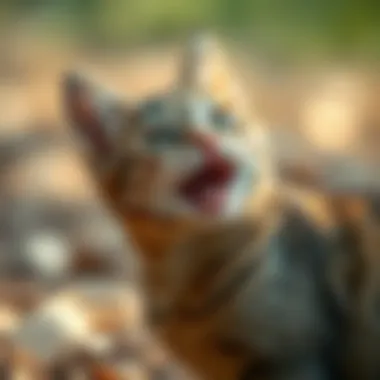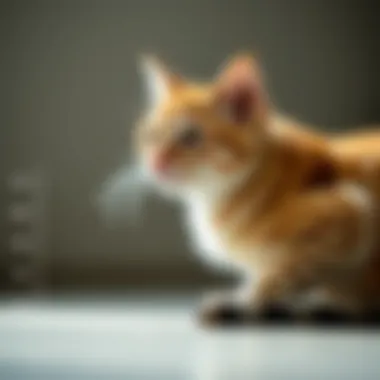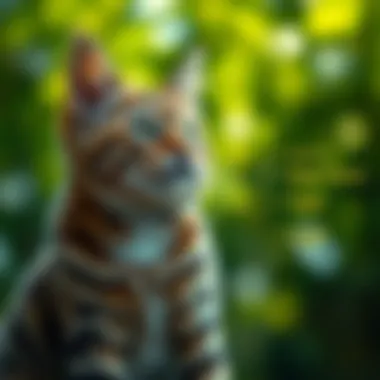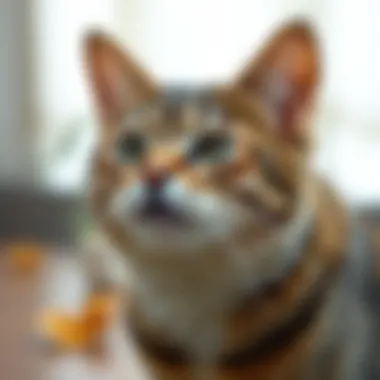Understanding Feline Heat Cycles: Frequency and Duration


Intro
Understanding a cat's heat cycle is essential for any dedicated pet owner. Not only does it help them manage their furry companion’s behaviors, but it also allows them to provide the right care and environment during a crucial time in their life. Felines, like many creatures in the animal kingdom, have natural reproductive cycles that occur at specific intervals. These cycles, marked by distinct physical and behavioral changes, can often leave owners puzzled.
When a cat enters heat, it’s not just a minor hiccup in routine; it can affect everything from daily interactions to overall pet care. This article sets out to demystify the feline heat cycle, shedding light on how frequently these cycles happen and for how long they last. Through a deep dive into the science behind these natural processes, we will cover key signs for owners to watch out for and practical strategies for pet care during these times. By understanding the intricacies of your cat's reproductive behavior, you'll be better equipped to navigate this phase smoothly and compassionately.
Pet Care Essentials
When your cat is in heat, attending to her specific needs becomes paramount. This phase can be demanding, not only for her but for you too. Let’s discuss the basic aspects of cat care that can make all the difference in managing this period effectively.
Daily Nutrition Requirements
Nourishing your feline friend with a balanced diet is critical, especially during her heat cycle. While a high-quality commercial cat food may suffice, consider adding some wet food for hydration. Cats can be quite picky about their food, so you might notice her showing particular preferences during this time. Ensure she has access to fresh water at all times as staying hydrated is key.
Exercise and Playtime
Exercise can help alleviate the nervous energy that often accompanies a cat in heat. Engaging her in interactive play can redirect some, perhaps frantic energy into more productive channels. Use feather wands or laser pointers to boost her spirits and keep her active. This not only helps her burn off excess energy but also strengthens the bond you share.
Grooming Tips
Regular grooming is crucial when your cat is in heat. You might find that she's more sensitive to touch, so approach grooming sessions with care, focusing on gentle strokes with a soft brush. This attention to her grooming needs not only keeps her coat in fine form but also reinforces your relationship with her.
Health and Wellness Check-ins
During this time, it’s wise to keep a closer eye on her overall health. Look out for any signs of distress or abnormalities, like excessive yowling, loss of appetite, or unusual lethargy. Regular health check-ins ensure you're in tune with her wellbeing. If things seem off, don’t hesitate to consult with your veterinarian.
Behavior & Training
Understanding behavior becomes even more essential when navigating the turbulent waters of a cat's heat cycle. Cats can exhibit a slew of behaviors during this time that may confuse or even frustrate their owners.
Understanding Your Pet's Body Language
Watch out for changes in your cat's body language. During heat, she might display more affectionate behaviors or, in some cases, become more territorial. Purring, rubbing against objects, or seeking your attention frequently can indicate that she's looking for companionship or simply trying to assert her territory.
Basic Training Techniques
Despite the hormonal shifts, you can still reinforce positive behaviors. For instance, when she does take a break from her antics to quiet down, reward that calmness with a treat or affection. It’s about striking a balance and not allowing her heat-related behaviors to overshadow training.
Behavioral Concerns & Solutions
If she becomes overly vocal, consider implementing a calm down routine, like setting her favorite cozy blanket in a quiet area of your home. It can help to create a serene environment, soothing her during a time that might feel overwhelming.
Socialization Tips
While it may seem tempting to prevent her from mingling with other cats, socialization doesn’t have to be completely cut off. Ensure introductions are supervised and avoid potentially confrontational interactions with unneutered males. It might not be ideal, but maintaining safe social exposure can provide her with avenues to express her natural instincts.
Prologue to Cat Heat Cycles
Understanding feline heat cycles is not only vital for cat owners, but it also plays a significant role in overall feline health and management. As cats reach sexual maturity, they experience heat cycles that signal their readiness to mate. Recognizing these cycles allows owners to provide the appropriate care, ensuring not only the comfort of their cats but also their own peace of mind.
The essence of grasping heat cycles lies in their frequency and duration. By knowing when these periods occur, owners can make informed decisions about spaying or managing their cats. Keeping in mind that not all breeds and individuals behave the same during these cycles, understanding the variations can help tailors choices to the specific needs of a pet.
In brief, the knowledge of feline heat cycles is integral for multiple reasons:
- Behavioral Management: Anticipating behavioral changes can save owners from unexpected disruptions in their routines.
- Health Awareness: Recognizing signs of distress or illness during heat can prompt timely veterinary care.
- Breeding Considerations: For those interested in breeding, knowing when a cat is in heat is key to maximizing potential litter size.
Overall, navigating the ins and outs of heat cycles not only enriches the pet-owner relationship but also fortifies a cat's well-being through informed choices and proactive care.
Definition of Heat Cycle in Cats
A cat's heat cycle, or estrous cycle, refers to the regular physiological changes that occur in female cats as they become sexually receptive. It typically commences when a cat reaches puberty, usually between five to twelve months of age, depending on factors like breed and health. The heat cycle itself consists of several stages, each characterized by distinct hormonal shifts and behavioral changes, indicating the cat's readiness to mate.


During this time, the female cat will exhibit a range of behaviors that signal her fertility. It’s vital to note that unlike humans, cats do not menstruate. Instead, they can enter multiple heat cycles throughout the year, particularly in warm seasons.
Key points include:
- The cycle is driven by hormonal levels that rise and fall, impacting the cat's receptivity to mating.
- Each cycle can span several days, repeating multiple times per year if the cat is not spayed.
- Understanding this cycle requires observing both hormonal and behavioral cues to manage effectively.
Importance of Understanding Heat Cycles
Grasping the intricacies of heat cycles is crucial for a variety of reasons. For one, it empowers cat owners to recognize when their pet is in heat, which can greatly influence their behavior. Cats may become more vocal, seek attention, or display restlessness during this time, and understanding these signs can mitigate confusion.
Another significant aspect is the physical health of the cat. Cat owners who are savvy about their pet's cycles can monitor any changes that might indicate health issues, such as prolonged heat or unusual discomfort. This knowledge can guide when to seek veterinary advice without delay.
Moreover, awareness of heat cycles plays a pivotal role for those considering breeding. Knowing the right time for mating can be crucial for successful litters. Initial attempts to breed often short-lived when owners are unacquainted with their cat’s heat cycles, leading to frustration and missed opportunities.
Ultimately, understanding feline heat cycles is akin to acquiring a toolkit for effective cat care. It not only aids in ensuring a cat’s comfort but also fosters a deeper bond between pet and owner through informed interaction and responsibility.
Frequency of Cats in Heat
Understanding how often cats go into heat is critical for cat owners, as it helps in managing both the emotional and physical welfare of their feline friends. Feline heat cycles can be an intense time for pets and their owners alike. Awareness about this frequency prepares owners for the behavioral and physical changes their cats might exhibit, ensuring they can provide adequate care and make informed decisions regarding their pet’s reproductive health.
This section delves into the frequency with which cats experience heat cycles, aiming to paint a clear picture of what to anticipate and how to respond.
Typical Frequency of Heat Cycles
Cats generally enter heat cycles multiple times a year, with most going in heat about two to three times during breeding seasons. A typical cycle lasts from a few days to a week. However, this might vary according to various factors. During spring and summer, when daylight hours increase, the heat cycles can become more pronounced. This is nature’s way to ensure that kittens born in warmer months will be able to survive.
"Knowing when your cat usually comes into heat can help you plan for any necessary care and avoid unexpected surprises."
Cats that are not spayed will continue to go into heat cyclically, and some may even display signs of being in heat for up to three weeks, particularly if a mate is nearby.
Factors Influencing Frequency
Several factors can influence how often a cat goes into heat:
Age
Age is a significant factor in a cat's heat frequency. Kittens typically enter their first heat cycle between six months and one year of age, sometimes sooner depending on their breed. Younger cats may have more frequent cycles as their bodies are in the prime of their reproductive phase. As cats age, their heat cycles might become irregular, often slowing down or ceasing altogether once they reach senior status. This natural decline can provide pet owners with relief from the challenges of managing a cat in heat.
Breed
Different breeds can have varying frequencies of heat cycles as well. Siamese and other Oriental breeds are known to experience more frequent heat cycles compared to other breeds. This means owners of these breeds should be particularly vigilant. Breed characteristics can significantly impact a cat’s reproductive health, leading to differences in how cats exhibit signs of being in heat. Additionally, some breeds are predisposed to specific health issues, which can also affect their cycling patterns. For example, a Persian cat may experience a less frequent but longer cycle due to its genetic makeup and overall health conditions.
Environmental factors
Environmental factors, including light exposure, temperature, and overall living conditions, can greatly influence how often and when a cat goes into heat. Cats are polyesters; they are triggered by changes in daylight. If a cat lives indoors in a dimly lit environment, it may experience fewer cycles despite being of reproductive age. Conversely, a cat exposed to longer periods of natural light may cycle more frequently during the breeding season. Owners should also consider the presence of other animals in the household, as the pheromones from unspayed females may prompt nearby cats to enter heat more frequently.
Duration of Heat Cycles
Understanding the duration of feline heat cycles is crucial for any cat owner. This knowledge enables pet parents to anticipate the behavioral and physiological changes their pets might undergo during these times. In particular, recognizing when a cat is in heat helps prevent unwanted pregnancies, fosters better management of their needs, and ensures both the animal and the owner are comfortable.
Cat heat cycles typically last for a period that can vary based on several factors, including age and breed. The ability to predict and recognize the signs associated with the duration gives a genuine sense of control and reassurance. Knowing that fluctuations can occur allows owners to be prepared and responsive.
Average Duration of Each Cycle
The average duration of a cat's heat cycle measures around six to seven days, but this can shift. Some cats may exhibit symptoms of estrus for as little as three days, while others may go through this phase for an extended time, up to two weeks. The cycle itself consists of a series of stages, with the most notable being proestrus and estrus. Each stage has its own length, affecting the overall heat cycle duration.
Regularly, a cat will go through these cycles several times a year. Yet, the exact duration and frequency depend largely on their individual biology.
Understanding this can assist owners in planning veterinary visits, spaying options, and overall cat care. Observing signs of estrus, characterized by vocalizations and increased affection, can further aid in tracking these cycles.
Variability in Duration
Variability in the duration of heat cycles presents both challenges and opportunities for cat owners. It's essential to understand how certain factors impact how long a cat stays in heat.


Individual Differences
Individual differences can play a significant role in how long a cat remains in heat. Age, genetics, and even the cat's health contribute to these individual responses. For instance, younger cats may have shorter cycles because their bodies are still maturing, while older cats can experience cycles that last longer or feel more intense.
Key characteristic: Each cat is unique. Some may show signs of being in heat more prominently, while others might not display typical behaviors. This uniqueness allows owners to develop tailored management strategies suited to their pet’s specifics.
Advantages: Understanding these individual patterns can help owners better cater to their cats. Recognizing when a pet may need extra attention or a quieter environment can make the heat cycle less stressful for both parties.
Health Implications
Health implications also play a critical role in the variability of heat cycle duration. Cats suffering from underlying health issues may experience irregularities in their cycles. Factors such as hormonal imbalances or infections can extend heat phases or cause inconsistencies.
Key characteristic: Regular check-ups and veterinary advice can shed light on health influences affecting a cat's reproductive cycles. By understanding the relationship between health and heat cycles, owners can make informed decisions about their cat’s reproductive health and overall care.
Advantages: Addressing health implications early can prevent complications and promote a better quality of life for cats. It leads to more informed dialogue with vets about spaying or other reproductive interventions.
Phases of the Heat Cycle
When discussing feline heat cycles, understanding the various phases is essential. Each phase carries distinct characteristics and implications for both the cat and her owner. Recognizing these phases can help owners prepare for the signs of heat and manage their cats more effectively. Knowledge about these stages allows for better awareness of a cat's needs and behaviors during this natural reproductive process, enhancing the bond between the pet and the caregiver.
Proestrus: The Initial Stage
Proestrus marks the beginning of the heat cycle and is often quite subtle. This phase generally lasts from a few days up to a week, depending on the individual cat. During proestrus, cats may begin to display some physical changes, such as slight swelling of the vulva, but they are often not yet receptive to mating. This stage is primarily characterized by behavioral changes: the cat might become more affectionate, rubbing against furniture or her owner, and may vocalize more than usual.
It’s also a time when cats may exhibit increased restlessness. Observing these early signs can be crucial, as they signify a transition into the more overtly sexually receptive phase – estrus. Understanding these subtle signals can also help avoid unintended breeding, ensuring that the cat remains healthy and happy.
Estrus: The Receptive Stage
Estrus is the glowing highlight of the heat cycle, the time when a cat is in full swing. Generally lasting about a week, this phase is often marked by dramatic changes in both behavior and physical signs. This is the stage when a female cat will actively seek out mating. Owners might notice more intense vocalizations, which can sound like loud yowling. The cat will often roll on the floor, raise her hindquarters, and may exhibit an unusual desire for attention.
During estrus, the vulva is highly swollen and may even show a discharge. These traits indicate a cat that is ready and willing to mate. It’s not uncommon for cats during this phase to act on instinct, which might lead them to try to escape from the home in search of a mate. This makes it particularly important for cat owners to be vigilant and prepared to keep their wandering feline secure during this time.
Metestrus and Anestrus Phases
Once the estrus cycle is complete, a cat transitions into metestrus, also known as diestrus. During this phase, which can last around two to three weeks, the cat's body is recovering from the heat cycle. If she has mated, this is a crucial period when she may become pregnant. If no mating occurred, her body will gradually return to its normal state.
After metestrus, cats enter anestrus, a period of reproductive inactivity. This phase can last several months, depending on the season and the cat's overall health. It's during this time that the cat essentially takes a breather from the heat cycles, allowing her body to recover. Understanding these phases helps owners identify which stage their cat is in and plan accordingly for her needs.
In summary, knowing the phases of the heat cycle is paramount for any cat owner. It allows for better management of both the cat’s health and the owner’s peace of mind.
Signs of a Cat in Heat
Recognizing the signs of a cat in heat is paramount for any cat owner. When a female cat is in this reproductive cycle, her behavior and physical characteristics undergo noticeable changes. Awareness of these signs not only helps owners manage their pets more effectively but also contributes to responsible feline parenting. Ignoring these changes can lead to unintended pregnancies or increased stress for both the cat and the owner.
Physical Signs to Observe
When a cat enters her heat cycle, there are several physical signs that become evident. These manifestations can be subtle or quite pronounced:
- Vocalization: One of the most apparent indicators is an increase in vocal sounds. Cats may yowl or cry more frequently, often sounding almost as if they are in distress. This loud and persistent vocalization serves to attract potential mates.
- Posturing: Female cats in heat will exhibit a specific posture known as lordosis. This means they arch their backs and raise their hindquarters, signaling their readiness to mate. This position might be mistaken for discomfort, but it’s a natural behavior.
- Increased Affection: During heat, a cat might become unusually affectionate, seeking out attention from their owners or even rubbing against furniture or walls. While this is typical behavior, the intensity can be striking.
- Nesting Behavior: Some cats may display nesting behaviors, which include seeking out small, quiet spaces like closets or behind furniture, as if preparing for possible pregnancy.
Being observant of these signs allows owners to better interpret their cat’s needs during this time. However, not all cats will exhibit every sign, and there might be differences in intensity among individual cats.
Behavioral Changes During Estrus
The behavior of a cat undergoing the estrus phase can also shift dramatically. Understanding these changes is crucial for owners to respond appropriately to their pet's needs:
- Increased Restlessness: A cat in heat often appears restless and may roam around more than usual. This behavior is a natural instinct, as they are instinctively searching for male companions.
- Marking Territory: Felines are known for their territorial nature, and females in heat often engage in marking their surroundings with urine. This is another method of signaling their availability to potential mates. Owners might notice an increase in this behavior during the heat cycle.
- Potential Aggression: Some cats can become irritable or defensive when approached, particularly if they feel threatened during this vulnerable time. This behavioral change may lead to conflicts with other pets in the household.
"Understanding these behaviors can aid cat owners in providing a calm and supportive environment for their pets during often tumultuous periods."
In summary, the physical and behavioral indicators of a cat in heat are crucial for any owner to recognize. By being attuned to these changes, pet owners can offer the support their cats need while navigating through this natural phase of feline life.
Implications of Heat Cycles for Cat Owners


Understanding the heat cycles of cats is pivotal for any responsible pet owner. Not only does it shed light on a cat’s natural behaviors, but it also guides owners in making informed care decisions during these periods. A cat in heat can present unique challenges, and acknowledging these implications is essential for maintaining a harmonious household. From managing behaviors to ensuring health considerations are met, the knowledge of what to expect can significantly improve both the owner's and the cat's experience.
Managing a Cat in Heat
Environmental Enrichment
One important aspect of managing a cat in heat is environmental enrichment. During this time, female cats may exhibit restlessness and increased vocalization. Providing a stimulating environment becomes crucial to keep them engaged. This could include scratching posts, puzzle feeders, and elevated perches. These enrichments help distract from their discomfort and may reduce the frustration that often accompanies their heat cycle.
The key characteristic of environmental enrichment is its ability to mimic the cat's natural instincts. Cats are curious creatures, and creating a vibrant space caters to their exploratory nature. This not only alleviates stress but also promotes mental stimulation, which can be beneficial as they deal with the hormonal fluctuations of their heat cycle.
However, one unique challenge with environmental enrichment during this time is ensuring safety. Cats, in a heightened state, may engage in riskier behaviors. Hence, it's important to monitor their interactions with new toys or structures. The advantages of environmental enrichment are clear: it calms a cat’s restlessness and reduces unwanted behaviors that can arise from anxiety.
Behavioral Considerations
In addition to physical distractions, understanding behavioral considerations is vital during this time. Female cats undergo various behavioral changes, like increased affection and marking territory. Owners should anticipate these changes and respond appropriately. A calmly adjusted owner's approach can make a world of difference in how the cat copes with her heat cycle.
The important point about behavioral consideration is recognizing that these behaviors are driven by biological instincts. They are not meant to be mischief; instead, they reflect the natural impulses that emerge during a cat's reproductive phase. By providing reassurance while setting reasonable limits, such as creating boundaries in the home, owners can navigate these changes effectively.
Despite their challenges, recognizing these behavioral characteristics allows for a more empathetic understanding of a cat’s needs. An owner aware of these unique features is better positioned to offer support, creating a positive atmosphere for both cat and human.
Health Considerations and Veterinary Advice
Health considerations should never take a backseat when discussing feline reproductive health. Regular veterinary check-ins before and during cycles can help identify any potential health issues early, ensuring your cat remains in top shape. Most, if not all, cats can benefit from discussing the option of spaying, which not only prevents unwanted heat cycles but also contributes to overall health.
It is crucial to ask questions from your vet regarding signs to be mindful of during these cycles. Any drastic changes in behavior or health should be reported as they can indicate health problems that need addressing. Veterinarians can provide tailored advice, fostering a proactive approach to pet care.
Preventive Measures and Alternatives
Understanding how to manage feline heat cycles is not just advantageous, it’s crucial for a well-rounded pet care approach. For many cat owners, the sight and sound of a cat in heat can be overwhelming. Hence, exploring preventive measures and alternatives can provide peace of mind and better health for our feline friends.
Options for Spaying
Spaying, often called ovariohysterectomy in veterinary terms, refers to the surgical removal of a female cat's ovaries and, often, her uterus. This procedure is widely recommended for various reasons. The following points highlight its importance:
- Prevention of Unwanted Litters: One of the most straightforward reasons for spaying is to prevent unexpected litters, which can overwhelm pet owners and animal shelters.
- Health Benefits: Spayed cats often have a significantly reduced risk of certain health concerns, including uterine infections and breast tumors, which can be life-threatening.
- Behavioral Improvement: After being spayed, many cats show a notable change in behavior. They tend to be less territorial and less prone to yowling or seeking male cats.
- Community Concerns: Reducing the number of stray or abandoned cats is a responsibility shared by all pet owners. Spaying contributes to lessening this problem.
It is crucial to consult with a veterinarian to determine the best age and timing for spaying, as well as to discuss any specific health considerations for your cat.
Behavior Modifications
While spaying is a primary recommendation, behavior modifications can also help manage the impact of heat cycles. Here are some strategies:
- Environmental Enrichment: Keeping a cat stimulated through enriching activities can redirect their focus. Options include interactive toys, climbing structures, and puzzle feeders. This can make the heat cycle less distressing for both the cat and the owner.
- Routine Changes: Adjusting the routine can help the cat feel more secure. For instance, spending extra time playing with your kitty or providing them with a cozy, quiet retreat can alleviate stress. Offering a safe space can help decrease anxiety during heightened hormonal periods.
- Distraction Techniques: During the heat cycle, provide various distractions such as new toys or engaging games. Cats like to scratch, climb, and chase, so promoting these activities can keep their minds busy.
- Feliway Products: Synthetic pheromones, like those found in Feliway, can provide comfort and security during stressful periods. These can help mitigate some signs of anxiety or aggression associated with being in heat.
Ultimately, keeping an open line of communication with a veterinarian can help hone in on the right preventive measures tailored to an individual cat's temperament and needs.
"Preventive measures are not just about avoiding problems; they’re about enhancing the quality of life for our pets."
Embracing both spaying and behavior modifications gives cat owners valuable tools at their disposal, allowing for a harmonious household dynamic even when navigating the natural, albeit challenging, reproductive cycle of their beloved pets.
The End: The Importance of Awareness
Understanding the cycles of feline heat is paramount not just for the health of cats, but also for their owners. When you grasp how these cycles operate, you can make informed choices about their care and overall well-being. An awareness of the frequency and duration of these cycles helps pet owners anticipate changes in their cat’s behavior, allowing for timely interventions.
Cats, being creatures governed by their instincts, experience heat cycles that are as natural as the changing seasons. When a cat is in heat, it's not merely a phase; it’s a signal that reminds us of their reproductive health. By understanding this biological phenomenon, owners can offset potential behavioral issues that arise during these times, such as increased vocalization and restlessness. The anxiety a cat may experience can, at times, spill over into their relationship with their human companions, making awareness a tool for harmony.
In addition, recognizing the signs of heat can bring about a deeper understanding of your pet's overall health. It’s essential to embrace knowledge about these cycles to better communicate with veterinarians and make educated decisions about spaying or considering other solutions that fit your lifestyle and your cat’s needs. This awareness bridges the gap between instinctual feline behavior and human responsibility, ensuring that both cat and owner navigate this territory with empathy and understanding.
"Awareness is like a two-way street—pawing at the unknown while guiding the journey ahead."
Summary of Key Points
- The heat cycle in cats can be complex, but knowledge provides clarity.
- Recognizing the signs during estrus can lead to better care and health decisions.
- Understanding these cycles helps in mitigating behavioral changes, making for a smoother home environment.
- Being informed empowers owners to take proactive steps, whether by spaying or by managing their feline’s needs during this period.
Final Thoughts on Cat Reproductive Health
In closing, the reproductive health of cats deserves attention. It's a world that, while biological, intertwines closely with our daily lives as pet parents. Awareness of feline heat cycles can significantly improve both the owner’s experience and the cat’s quality of life. By staying informed, you not only foster a healthier environment but also nurture a stronger bond with your feline companion.
As responsible pet guardians, the choices made during these times echo into the future. Either through preventive measures or simply being present with understanding, we can enhance not just the life of our pets, but also enrich our own lives in this feline-filled journey.







